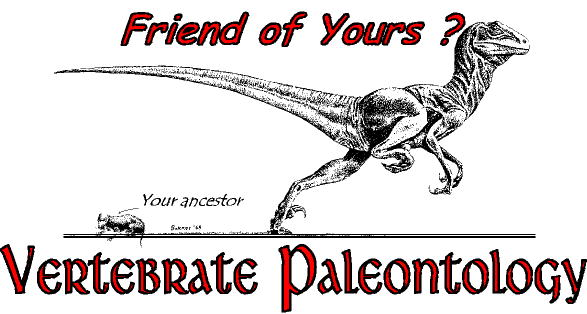
About the Course
233 Miller Hall - phone 6531
Vertebrate Paleotology is an elective course exploring the origin and history of the vertebrate taught by Lynn S. Fichter at James Madison University. The course is meant for for geology and biology majors and I work to speak to both groups equally. My undergraduate degree is in biology, plus my graduate work (MS and PhD are both in vertebrate paleontology) included course work and advsors in both zoology and geology so I know the backgrounds and perspectives of both groups.
I have placed prerequisites of either an introductory geology or an introductory biology course, but they are technically not necessary. Because the course has in the past had geologists with little background in biology, and biologists with little background in geology, I have learned that I must provide background to both groups for many of the subjects taught. Permission of the instructor should be gained if you are not sure you are prepared for the class but it has never been a problem in the past.
My graduate degrees are in this subject, and I love teaching it. Although most of my work is now done in geology I have never lost my fascination with paleotology and am willing to work with anyone who wants to take the course. Questions during class are encouraged and expected. If a question requires a more extended answer I will work with people outside of class.
Technically there is not a lab for the course, but part of the course requires you to study and learn the basic vertebrate skeleton, the skulls of three vertebrates, and a set of mammalian teeth. This is not directly taught in the class but is done on your own with the help of lab guides. To understand how evolution has occurred it is necessary to talk about specific bones and their transformations through time. This requires knowledge of them and that comes first by studying these skeletons. I have thought about including a formal lab in the course and upping the credits to 4 but I think that would require expanding the number of skeletons and skulls learned beyond what is done here, and unless you have a special interest in learning those things it is not necessary to do the course. So, learning the bones lies in the never-never, inbetween land; enough to require some extra work on your part, but not enough to warrant an additional credit. Still, I think you will find that learning these bones will enormously enhance your understanding of the evolution we study.
Return to Biology/Geology 405: Vertebrate Paleontology home page